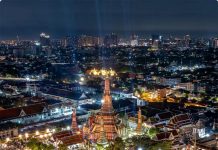Bangkok, July 16, 2012 — The Tourism Authority of Thailand has unveiled a series of strategies designed to maintain Thailand’s brand image, marketing profile and visitor arrivals in a world of unprecedented change.
Announced today after the conclusion of the TAT’s annual action planning meeting, the strategies are designed to ensure that the travel and tourism industry takes advantage of all the emerging opportunities while preparing itself to deal with any threats and challenges, both external and internal.

The TAT has set a 2013 target of 22.22 million international tourist arrivals, generating estimated foreign exchange revenues of 966 billion baht (USD 30.62 billion, based on the exchange rate of 31.54 baht to the dollar).
Said TAT Governor Suraphon Svetasreni, “Tourism is now recognised as Thailand’s most important service industry. Its contribution to job creation, income distribution and foreign exchange earnings is well above par. While the industry has been doing well so far, it cannot rest on its laurels in an unstable and unpredictable world.”
The primary determinant of how travel and tourism performs in future will be global economic and geopolitical stability. If this continues, there will be no shortage of opportunities, technologies and activities to capitalize on demand.
By far the most important opportunity is the emergence of the ASEAN Economic Community and prospects of free movement of products and people by 2015. These opportunities increase manifold when the nearly 600 million strong population of the 10 ASEAN countries is expanded to include ASEAN +3 (China, Japan and South Korea) and beyond by another three countries to include ASEAN +6 (Russia, India and Australia).
To capitalize on this, the TAT has crafted the “Thailand and Beyond Strategy” to be ready for AEC in 2015.
At the same time, some traditional source markets such as Europe are slowing down while other new markets such as Africa are emerging. It is also becoming an increasingly competitive market as just about every global destination joins the tourism promotion bandwagon.
Meanwhile, global demographics are also changing with ageing populations in some countries and more young populations in others. Either way, Thailand is fortunate to have a range of products, both natural and man-made, that are well suited to meeting demand.
Overall, the TAT has to ensure creativity and visibility by highlighting Thailand’s unique strengths, and undertake campaigns that target the right customer with the right message and right product at the right place at the right time.
Here are some of the highlights of the 2013 Action Plan:
The core theme of the 2013 TAT Action Plan is “Higher Revenue through Thainess”. The TAT will attract tourists with the Charm of Thainess which includes Thai Experience, Thai Way of Life, and Thai Culture.
The marketing messages will emphasize Creative Tourism, where tourists can participate in and learn about unique Thai experiences, such as Thai boxing, Thai massage, Thai cooking, and Thai classical dancing. Thai food and Thai local wisdom will also be used as unique selling propositions.
One campaign, known as “Discover The Other You” will be especially important in order to promote experiential travel––which taps into a global desire among visitors to learn something new and acquire a new experience.
Some key aspects of Thai lifestyles include basic things such as rice farming, massage and meditation techniques, will also be used. For the first time images for visitors participating in a rice harvest and ploughing the fields behind a water buffalo will be used in Thai marketing campaigns.
TAT will put more effort to increase first-time visitors and high spenders (luxury markets). Four niche products used to attract high-spenders will be Golf, Health & Wellness, Wedding & Honeymoon, and Green Tourism.
TAT will try to increase charter and low-cost carrier flights to destinations where there is no direct access. LCC’s will also be used to broaden the base for mainstream tourists.
A Partner on Demand strategy will be used to increase the number of strategic alliances and enhance the add-on impact of marketing efforts.
Trade shows and road shows will be extensively used in both main markets and new potential markets.
All the major global media will be used, especially sports and special-interest TV channels. The same strategy will be used in the print media, especially to reach business executives.
The new digital media will be a special focus of attention. Partnerships will also be forged with hotel partners to produce and show special interest videos such as those highlighting weddings and honeymoons.
The TAT will also put considerable emphasis on a tourism intelligence unit and a crisis management centre. These will be designed to sharpen research skills in order to identify emerging trends and opportunities, and also react efficiently and promptly to the increasing number of global crises.




